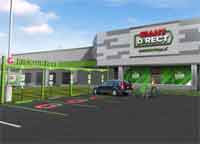| |
|
| |
|
 |
Supply
Chain by the Numbers |
| |
|
| |
- Jan. 31, 2019 -
|
| |
|
| |
|
| |
|
| |
Major Change in Foxconn US Factory Plans; Amazon Flex Drivers Worried; AI will Indeed Eliminate Many Jobs; Giant Foods Building eCom Only Store |
| |
|
| |
| |
| |
| |
1000 |
|
That is now about how many workers Taiwanese manufacturing giant Foxcomm now says it will have in the Racine, WI area by the end of 2020, not the 5200 promised when the company announced in 2017 plans to build a giant flat screen manufacturing campus in Southeast Wisconsin. Ultimately the factory could employ as many as 13,000 blue and white collar employees, Foxconn said at the time, a figure it reconfirmed in early January. Now the stunning reversal, in news first reported by Reuters this week. Not only will the number of jobs be far, far below initial projects, resulting in billions of dollars of planned government spending to acquire land, build infrastructure and more, plus providing giant tax incentives. Now, Foxconn says there is unlikely to be any factory at all, with the plan instead for a "technology hub" that will employ mostly engineers and technicians, though it may include some assembly and packaging operations. "In terms of TV, we have no place in the US," Foxconn CEO Terry Gou said this week. "We can't compete." Rather than manufacturing LCD panels in the United States, Woo said it would be more profitable to make them in greater China and Japan, ship them to Mexico for final assembly, and import the finished product to the United States. This amazing change has raise many question and political rancor, though whether state policies and actions were really any factor here is unclear. |
|
|
| |
| |
|
|
|
That's the effective hourly wage that Amazon Flex drivers are making currently after the program was announced in 2016. But now, Flex drivers, who deliver parcels to homes using their own cars, are seeing their delivery volumes go way down. Why? Amazon's Delivery Service Partners (DSP) program, in which local entrepreneurs lease as many as 40 delivery vans from Amazon and hire drivers to take packages to consumers in company branded vehicles. The wage paid to those drivers: typically a much lower $13-15 per hour, according to an article this week in Business Insider. Drivers for Delivery Service Partners also have another advantage over Flex drivers: They can deliver far more packages in a single route. One DSP driver can do the work of five or six Flexers. "The contractor [DSP] drivers are getting all the work, while we have to fight for blocks," said Rose Wellman, a Flex driver based in Charlotte, NC. In fact, as Amazon grows its DSP network even further, some drivers are speculating that the Flex program will disappear entirely. And indeed, Amazon in November ended Flex in the Greensboro, NC area.
|
| |
| |
|
| |
| |
| |
38,000 |
 |
That's the size of a new grocery "store" to be opened next month by Giant Foods, a division of Ahold Delhaize USA, near Lancaster, PA But the store won't have any consumers inside. Instead, the facility will provide a pickup venue for customers ordering groceries through the retailer's Peapod online service and app, as well as via Giant's website. The Giant Direct facility will serve as a curbside pickup site as well as a grocery delivery center. Specially designated "Pick Up Here" parking spaces will enable online customers to drive up and have their orders brought to their cars. The hub also will have a walk-up vestibule for picking up and placing online grocery orders, with the latter accomplished using tablets. Such online only grocery centers are popular in Europe, but are still rare in the US. |
| |
| |
| |
|
|
|
| |
 |
 |
| |
|
|
| |